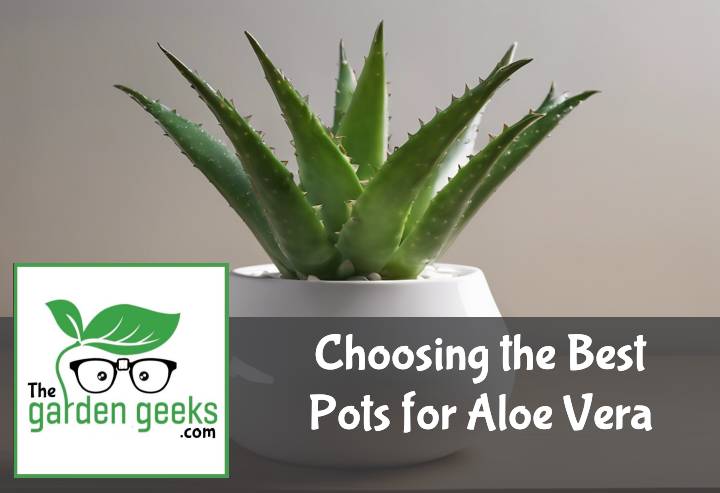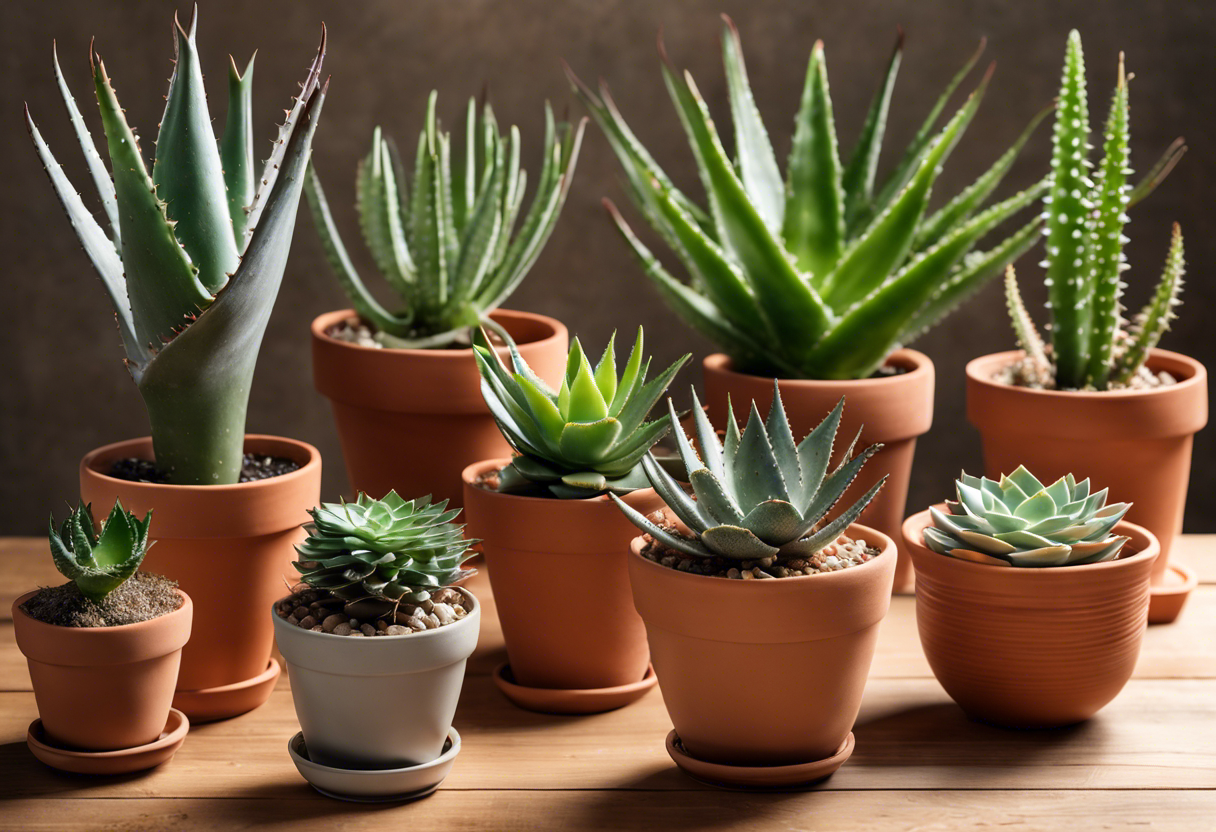Ever had a moment where you’re standing in the gardening section of your local store, staring at a wall of pots and thinking, “Which one is the Best Pots for Aloe Vera?” Well, you’re not alone. Choosing the right pot can feel like a game of ‘eeny, meeny, miny, moe’ but with more consequences for your beloved green friend.
In this blog post, we’ll unravel the mystery behind choosing the perfect home for your Aloe Vera. From size to material to drainage – we’ve got it all covered. So buckle up and let’s embark on this botanical journey together! Keep reading about Choosing the Best Pots for Aloe Vera (With Examples).
Key Takeaways
- Terra cotta pots are ideal for aloe vera due to their porous nature, allowing excess water to evaporate.
- Plastic pots can be used but require careful watering to prevent waterlogging.
- Choose pots with drainage holes to avoid root rot.
- The size of the pot should be proportional to the size of the aloe plant; too large can lead to overwatering.
- Examples of suitable pots include the Fox & Fern Plant Pot and Mkono Terracotta Pot.
Why is Choosing the Right Pot for Aloe Vera Important?
Choosing the right pot for your aloe vera isn’t just about aesthetics. It’s a crucial aspect of aloe vera pot selection that directly impacts the plant’s growth and overall health. The importance of the right pot can’t be overstated, as it plays a significant role in determining how well your aloe vera thrives.
The Role of Pots in Aloe Vera Growth
The role of pots in aloe vera growth is more critical than you might think. The type and size of the pot you choose can significantly influence your plant’s development. For instance, a small pot may restrict root expansion, stunting the plant’s growth.
On the other hand, an overly large pot could lead to waterlogging, which isn’t ideal for aloe vera either. Hence, finding that sweet spot with the pot type and size is essential for optimal aloe vera development.
Impact of Wrong Pot Choice on Aloe Vera Health
Now let’s talk about what happens when you make an inappropriate pot selection. An incorrect choice can have negative effects on your plant’s health and longevity.
For example, choosing a non-draining pot can cause water to accumulate at the bottom, leading to root rot – not exactly what we want for our green friends! Similarly, a too-small or too-large pot can stress out your plant, affecting its lifespan negatively.
In conclusion, understanding the impact of wrong pot choice on aloe vera health is key to ensuring your plant lives long and prospers. So remember folks – when it comes to picking out the best pots for Aloe Vera, size does matter!
What are the Key Factors to Consider When Choosing a Pot for Aloe Vera?
When it comes to Aloe Vera pot selection, there’s more than meets the eye. You can’t just grab any old container and call it a day. No siree! There are key factors in choosing pots that can greatly affect your plant’s health and growth.
Size of the Pot
First things first, size matters! The ideal pot size for Aloe Vera isn’t too big or too small – it’s just right. Too large, and your plant might feel like it’s swimming in an ocean of soil, which could lead to root rot. On the other hand, if the pot is too small, your Aloe may feel cramped and its growth could be stunted.
So what’s the sweet spot? Well, generally speaking, you want a pot that’s about as wide as the length of your Aloe Vera leaf. That way, there’s enough room for roots to spread out comfortably without drowning in excess dirt.
Material of the Pot
Next up on our list of considerations is material. The best material for Aloe Vera pots depends on where you live and how often you’re willing to water your plant.
For instance, clay or terracotta pots are great because they allow soil to dry out quickly which is perfect for those who tend to overwater their plants (you know who you are!). However, these materials can crack in cold weather so they might not be ideal if you live somewhere with harsh winters.
On the flip side, plastic pots retain moisture longer which means less watering but also higher risk of root rot if you’re not careful.
Drainage System in the Pot
Last but definitely not least is drainage system. This is a game changer folks! An effective drainage system is crucial for growing healthy Aloe Vera plants.
Why? Because Aloe Vera, like other succulents, doesn’t like to have wet feet. Too much water can lead to root rot and other nasty problems. That’s why it’s so important to choose a pot with good drainage.
So when you’re out there selecting Aloe Vera pots, make sure you pick one with plenty of holes at the bottom. This allows excess water to escape, keeping your plant happy and healthy. And remember, a happy plant makes for a happy plant parent!
How Does Each Factor Influence the Growth and Health of Aloe Vera?
When it comes to Aloe Vera growth factors, the size, material, and drainage of the pot play a vital role. These elements have a significant influence on Aloe Vera health.
Effect of Pot Size on Aloe Vera
The pot size for Aloe Vera can make or break its growth. Too small, and your plant might feel cramped. Too big, and it may drown in excess soil moisture. The impact of pot size on Aloe Vera is real folks!
Finding the optimal pot size for a healthy Aloe Vera is like Goldilocks finding the perfect porridge – not too hot, not too cold, just right! This ensures your plant has enough room to grow without getting waterlogged.
Influence of Pot Material on Aloe Vera
Now let’s talk about what your pot’s made of. The best pot material for Aloe Vera can vary depending on your environment. Some swear by ceramic pots while others are all about plastic.
The key here is understanding how each material impacts your plant’s health. For instance, ceramic pots are breathable but they can also dry out quickly. On the other hand, plastic pots retain moisture but may lead to root rot if not properly managed.
Importance of Proper Drainage for Aloe Vera
Last but definitely not least – drainage! The importance of drainage in growing Aloes cannot be overstated. Without proper drainage, water can accumulate at the bottom of the pot leading to root rot.
Poor drainage is like a bad roommate who never cleans up after themselves – nobody wants that! So when choosing the best pots for Aloe Vera, always ensure they have adequate drainage holes at the bottom.
Remember folks, happy roots make happy plants!
What are Some Examples of Best Pots for Aloe Vera?
When it comes to choosing the best pots for Aloe Vera, there’s a bit of a Goldilocks situation. You’ve got ceramic, terracotta, and plastic pots. Each has its own charm and challenges.
Example 1: Ceramic Pots
First up, we have ceramic pots for Aloe Vera. These beauties are known for their good looks and solid structure. They’re sturdy, heavy-duty, and they don’t tip over easily. But that’s not all sunshine and rainbows.
The downside? They can be a tad heavy. And if you’re an indoor gardener with limited space, this might be a deal-breaker. Plus, they don’t breathe as well as other options.
Ideal conditions? If you live in a hot climate where the sun is always out to play, ceramic pots can help keep your Aloe cool.
Example 2: Terracotta Pots
Next on our list are terracotta pots for Aloe Vera. Now these guys are the life of the party! They’re breathable which means they allow excess water to escape easily – perfect for preventing root rot!
But hold your horses! There’s a catch. Terracotta dries out faster than other materials which means more watering work for you.
Ideal conditions? If you’re prone to overwatering or live in a humid area, terracotta could be your new best friend.
Example 3: Plastic Pots
Last but not least, let’s talk about plastic pots for Aloe Vera. These lightweight champs are easy to move around and won’t break the bank (or your back).
But wait! There’s more! Plastic retains moisture longer which can be both good and bad news depending on how trigger-happy you are with the watering can.
Ideal conditions? If you’re a forgetful waterer or live in a dry climate, plastic pots might just save your Aloe’s life.
Common Mistakes to Avoid When Choosing a Pot for Aloe Vera
When it comes to picking the best pots for Aloe Vera, folks often stumble over a few common pitfalls. Let’s dive into these Aloe Vera pot mistakes and learn how to avoid them.
Overly Large or Small Pots
Choosing a pot that’s too large can be just as detrimental as one that’s too small. An oversized container may cause the soil to dry slowly, leading to root rot. On the flip side, a tiny pot can cramp your plant’s style, stunting its growth. So remember, when it comes to wrong pot size for Aloe Vera, Goldilocks had it right – not too big, not too small, just right!
Inadequate Drainage
Poor drainage is like a bad date – it leaves your Aloe Vera feeling soggy and miserable. Waterlogged soil can lead to root rot, which is pretty much the kiss of death for your green buddy. So don’t skimp on those drainage holes! Remember, drainage importance for Aloe Vera cannot be overstated.
Wrong Material Choice
Not all pots are created equal. Some materials might look pretty but can retain heat or lack durability – both no-nos when choosing the best material for Aloe Vera pots. Your plant prefers its home cool and long-lasting, so choose wisely!
To Wrap Up
Choosing the Best Pots for Aloe Vera is like picking the perfect pair of shoes for a marathon – it can make or break your plant’s growth journey. Remember, drainage, size, and material are your three key musketeers in this quest.
So, don’t just stand there! Get pot-hunting and give your aloe vera the home it deserves. Happy gardening!





